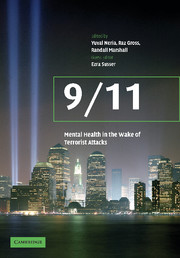Book contents
- Frontmatter
- Contents
- Acknowledgments
- Editors brief bio
- List of contributors
- Foreword
- Part I Introduction
- Part II The psychological aftermath of 9/11
- 2 Preface
- 3 Post-traumatic stress symptoms in the general population after a disaster: implications for public health
- 4 Coping with a national trauma: a nationwide longitudinal study of responses to the terrorist attacks of September 11
- 5 An epidemiological response to disaster: the post-9/11 psychological needs assessment of New York City public school students
- 6 Historical perspective and future directions in research on psychiatric consequences of terrorism and other disasters
- 7 Capturing the impact of large-scale events through epidemiological research
- 8 Mental health research in the aftermath of disasters: using the right methods to ask the right questions
- Part III Reducing the burden: community response and community recovery
- Part IV Outreach and intervention in the wake of terrorist attacks
- Part IV A New York area
- Part IV B Washington, DC
- Part IV C Prolonged-exposure treatment as a core resource for clinicians in the community: dissemination of trauma knowledge post-disaster
- Part V Disasters and mental health: perspectives on response and preparedness
- Index
6 - Historical perspective and future directions in research on psychiatric consequences of terrorism and other disasters
from Part II - The psychological aftermath of 9/11
Published online by Cambridge University Press: 27 October 2009
- Frontmatter
- Contents
- Acknowledgments
- Editors brief bio
- List of contributors
- Foreword
- Part I Introduction
- Part II The psychological aftermath of 9/11
- 2 Preface
- 3 Post-traumatic stress symptoms in the general population after a disaster: implications for public health
- 4 Coping with a national trauma: a nationwide longitudinal study of responses to the terrorist attacks of September 11
- 5 An epidemiological response to disaster: the post-9/11 psychological needs assessment of New York City public school students
- 6 Historical perspective and future directions in research on psychiatric consequences of terrorism and other disasters
- 7 Capturing the impact of large-scale events through epidemiological research
- 8 Mental health research in the aftermath of disasters: using the right methods to ask the right questions
- Part III Reducing the burden: community response and community recovery
- Part IV Outreach and intervention in the wake of terrorist attacks
- Part IV A New York area
- Part IV B Washington, DC
- Part IV C Prolonged-exposure treatment as a core resource for clinicians in the community: dissemination of trauma knowledge post-disaster
- Part V Disasters and mental health: perspectives on response and preparedness
- Index
Summary
Introduction
This chapter will review the history of research on disasters and terrorism leading up to the state of the field at the time of the September 11th terrorist attacks and the methodological challenges faced in responding to this unprecedented event. This chapter will also discuss translations of empirical data to clinical intervention and policy, and the ramifications of disaster studies for future research and disaster planning.
Historical perspective
Catastrophic events have plagued mankind since the beginning of history. Emotional effects of disasters were recorded 4000 years ago in Egyptian cuneiform records (Kramer, 1969) and later in the Iliad of Homer (Shay, 1991). The Biblical floods of the Book of Genesis are even older, dating to approximately 5600 bc (Ryan & Pitman, 1998). Although history has provided ample opportunity to study psychiatric consequences of disasters, this area is a relatively new field of scientific inquiry.
The first medical literature on psychiatric sequelae of disasters can be found in descriptions of Railroad Spine Syndrome by John Erichsen in 1867 in connection with locomotive accidents in England (Fischer-Homberger, 1970; Trimble, 1981). At the time, Railroad Spine Syndrome was thought to be caused by physical damage to the spinal cord (Erichsen, 1875). It was not long, however, before experts identified psychiatric origins to the syndrome, attributing its manifestations to extreme fear (Page, 1885) or hysterical neurosis (Putnam, 1883), possibly representing the first modern recognition of psychiatric origins in posttraumatic syndromes.
War has provided opportunities to observe mass psychological casualties in soldiers.
- Type
- Chapter
- Information
- 9/11: Mental Health in the Wake of Terrorist Attacks , pp. 95 - 113Publisher: Cambridge University PressPrint publication year: 2006
- 1
- Cited by



